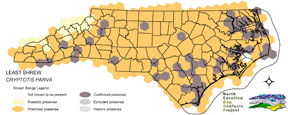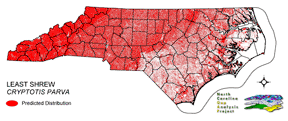
| Taxa: |
| Order: |
| Family: |
| Mammalia |
| Insectivora |
| Soricidae |
| NatureServe Global Rank: |
| NatureServe State (NC) Rank: |
| G5 |
| S5 |
| Federal Status: |
| NC State Status: |
| --- |
| --- |


| Land Unit |
| US Fish & Wildlife Service |
| US Forest Service |
| US National Park Service |
| US Department of Defense |
| NC State Parks |
| NC University System |
| NC Wildlife Res. Com. |
| NC Forest Service |
| NC Div. of Coastal Mgmt. |
| Local Governments |
| Non-Governmental Org. |
| Other Public Lands |
| Private Lands |
| GAP Status 1-2 |
| All Protected Lands |
| Statewide |
| Hectares |
| 33,661.71 |
| 404,563.95 |
| 61,071.75 |
| 112,917.33 |
| 33,487.02 |
| 13,871.61 |
| 53,682.48 |
| 8,657.37 |
| 2,593.89 |
| 9,700.92 |
| 13,008.42 |
| 3,116.16 |
| 6,467,778.00 |
| 261,658.17 |
| 746,889.12 |
| 7,218,110.61 |
| Acres |
| 83,179.88 |
| 999,699.10 |
| 150,911.55 |
| 279,024.74 |
| 82,748.21 |
| 34,277.49 |
| 132,652.27 |
| 24,504.13 |
| 6,409.64 |
| 23,971.49 |
| 32,144.50 |
| 7,700.20 |
| 15,982,224.39 |
| 649,682.60 |
| 1,848,714.15 |
| 17,839,447.59 |
| % of Dist. on |
| Prot. Lands |
| 4.5 % |
| 54.2 % |
| 8.0 % |
| 15.1 % |
| 4.5 % |
| 1.9 % |
| 7.1 % |
| 1.2 % |
| 0.3 % |
| 1.7 % |
| 1.7 % |
| 0.3 % |
| < 0.1 % |
| 35.0 % |
| ----- |
| ----- |
| % of Dist. on |
| All Lands |
| 0.5 % |
| 5.6 % |
| 0.8 % |
| 1.6 % |
| 0.5 % |
| 0.2 % |
| 0.7 % |
| 0.1 % |
| < 0.1 % |
| 0.1 % |
| 0.2 % |
| < 0.1 % |
| 89.6 % |
| 3.6 % |
| ----- |
| ----- |
|
Found throughout the state, C. parva uses a variety of habitats, but is most commonly associated with relatively open habitats dominated by herbaceous vegetation. This shrew also inhabits the maritime forests and salt marshes of the coastal barrier islands (Webster et al. 1985). Optimal habitats seem to be old fields, meadows or marshes near wooded or
brushy areas (Webster et al. 1985). Also, found in pine woods with dense herbaceous cover, and in forest openings of grassy, weedy, and brushy condition (Whitaker and Hamilton 1998). NATURE SERVE GLOBAL HABITAT COMMENTS: Generally occurs in open country with dense herbaceous vegetation. Also brushy areas, forest edges, and sometimes salt and freshwater marshes. Sometimes in scrubby live oak, pine-oak, dense humid tropical forest, and cloud forest, and near water in Mexico and Central America. Nest site may be underground or under log, stump, rock, board. |
| Code | Name | Description | NC Natural Heritage Program Equivalent |
| 3 | Tidal Marsh | Fresh and brackish tidal marshes, including cord grass, wild rice, sawgrass and needlerush alliances. | Brackish Marsh, Interdune pond, Maritime wet grassland |
| 124 | Maritime Scrubs and Tidal Shrublands | Coastal shrubs including wax-myrtle, swamp rose, alder, yaupon, and greenbriar. | Maritime Shrubs, Salt Shrub |
| 372 | Interdune Herbaceous Wetlands | Dune swales with permanently flooded to intermittently exposed hydrology. Species composition depends on salinity and can include cut grass, spike-rush, mosquito fern, and hornwort. | Interdune Pond, Maritime Wet Grasslands |
| 121 | Maritime Pinelands | Loblolly forests and woodlands of the outer coastal plain. | Estuarine Fringe Loblolly Pine Forest |
| 17 | Maritime Forests and Hammocks | Maritime forests and woodlands dominated by live or sand laurel oak. Estuarine Fringe forests dominated by loblolly pine. | Coastal Fringe Evergreen Forest, Maritime Deciduous Forest, Maritime Deciduous Forest |
| 126 | Interdune Wooded Depression Swamp | Includes swamps dominated by sweetbay and swampbay or dogwood dominated forests. | Maritime Shrub Swamp, Maritime Swamp Forest |
| 15 | Seepage and Streamhead Swamps | Includes extensive peat flats in the coastal plain, dominated by swamp tupelo, maples, and Atlantic white cedar alliances. In the sandhills includes streamhead pond pine and bay forests alliances. Saturated hydrology. | Bay Forest, Small Depression Pocosin, Streamhead Atlantic White Cedar Forest, Streamhead Pocosins |
| 63 | Coastal Plain Mesic Hardwood Forests | Beech dominated forests with white oak and northern red oak as possible co-dominants. Dry-mesic to mesic forests on slopes and small stream bottoms in the coastal plain. | Mesic Mixed Hardwood Forest, Basic Mesic Forests |
| 138 | Coastal Plain Dry to Dry-Mesic Oak Forests | Oak dominated forests of the coastal plain. Includes white oak forests with water oak or northern red oak and hickories as co-dominants. | Dry Mesic Oak Hickory Forest, Basic Oak Hickory Forest, Dry Oak Hickory Forest |
| 67 | Wet Longleaf or Slash Pine Savanna | Wet flatwoods and pine savannas, typically dominated by longleaf pines, but slash or pond pines may be the dominant pines. | Wet Pine Flatwoods |
| 97 | Mesic Longleaf Pine | Longleaf pine woodlands without a major scrub oak component. Slash or loblolly pines may be present as well. | Mesic Pine Flatwoods |
| 230 | Piedmont Mesic Forest | American Beech - Red Oak - White Oak Forests. | Mesic Mixed Hardwood |
| 383 | Piedmont Mixed Successional Forest | Generally loblolly mixed with successional hardwoods. Sweetgum, tulip poplar and red maple are common co-dominants in these successional forests. | No equivalent |
| 228 | Piedmont Dry-Mesic Oak and Hardwood Forests | Primarily oak dominated forests, white oak is often dominant, with co-dominants including . Also represented by sweetgum and tulip poplar dominated forests. | Dry Mesic Oak Hickory Forest, Basic Oak Hickory Forest, Dry Oak Hickory Forest |
| 222 | Piedmont Dry-Mesic Pine Forests | Loblolly dominated forests resulting from succession following clearing. This type occurs on all moisture regimes following disturbance with the exception of the extremely xeric sites. | No equivalent |
| 382 | Dry Mesic Oak Pine Forests | Mixed forests of the coastal plain and piedmont. Includes loblolly pine with white, southern red and/or post oak and loblolly with water oak. On basic sites of the piedmont, eastern red cedar may co-occur with post, black, and blackjack oaks. | Dry Mesic Oak Hickory Forest, Xeric Hard Pan Forest, Chestnut Oak Forest, Dry Mesic Oak Hickory Forest, Dry Oak Hickory Forest |
| 21 | Coniferous Cultivated Plantation (natural / planted) | Managed pine plantations, densely planted. Most planted stands are loblolly, but slash and longleaf occur as well. | No equivalent |
| 36 | Successional Deciduous Forests | Regenerating deciduous trees with a shrub stature. Commonly dominated by sweetgum, tulip poplars and maples. | No equivalent |
| 205 | Agricultural Pasture/Hay and Natural Herbaceous | Farm fields used for pasture grass or hay production, as well as old fields dominated by native and exotic grasses. | No equivalent |
| 202 | Residential Urban | Includes vegetation interspersed in residential areas. Includes lawns, mixed species woodlots, and horticultural shrubs. Vegetation accounts for between 20 - 70% of the cover. | No equivalent |
| 522 | Northern Hardwoods | High Elevation forests including yellow birch, American beech, and yellow buckeye. Includes forests with Hemlock and Yellow Birch. | Northern Hardwoods Forest, Boulderfield Forest |
| 523 | Grassy Bald | High Elevation grassy balds including Pennsylvania sedge, mountain oatgrass, as well as shrubby areas dominated by Alleghany and smooth blackberry. | Grassy Bald |
| 525 | Appalachian Oak Forest | A variety of oak forest types including Black, White, Scarlet Oaks in dry to mesic situations. Includes forests historically co-dominated by American Chestnut. | High Elevation Red Oak Forest, Montane White Oak Forest |
| 526 | Appalachian Cove Forest | Mixed Mesophytic forests of the mountains. Includes tuliptree, basswood, yellow buckeye and surgar maple. This class is mapped to include cove forests dominated or co-dominated by hemlock. | Rich Cove Forest, Acidic Cove Forest |
| 527 | Appalachian Hemlock | Upland hemlock forests of the moutains region. Vary from side slopes to steep slope positions. | Canada Hemlock Forest |
|
Hoffmeister, D.F., and C.O. Mohr. 1957. Fieldbook of Illinois mammals. Illionis Nat. Hist. Surv. Div., Manual 4. 233 pp.
Evers, D. C. 1992. A guide to Michigan's endangered wildlife. Univ. Michigan Press, Ann Arbor. viii + 103 pp. Jones, J. K., Jr., et al. 1992. Revised checklist of North American mammals north of Mexico, 1991. Occas. Pap. Mus., Texas Tech Univ. (146):1-23. Wilson, D. E., and D. M. Reeder (editors). 1993. Mammal Species of the World:a Taxonomic and Geographic Reference. Second Edition. Smithsonian Institution Press, Washington, DC. xviii + 1206 pp. Whitaker, J.O. Jr. and W.J. Hamilton, Jr. 1998. Mammals of the eastern United States. Cornell Univ. Press, Ithaca, New York. 583 pp. Whitaker, J. O., Jr. 1974. CRYPTOTIS PARVA. Am. Soc. Mamm., Mammalian Species No. 43:1-8. Choate, J. R. 1970. Systematics and zoogeography of Middle American shrews of the genus Cryptotis. Univ. Kansas Pub. Mus. Nat. Hist. 19:195-317. Godin, A.J. 1977. Wild Mammals of New England. Johns Hopkins University Press, Baltimore. 304 pp. Hamilton, William J., Jr., and John O. Whitaker, Jr. 1979. Mammals of the eastern United States. Cornell Univ. Press, Ithaca, New York. 346 pp. Hall, E. R. 1981. The Mammals of North America. Second edition. 2 Volumes. John Wiley and Sons, New York, New York. Schwartz, Charles W., and Elizabeth R. Schwartz. 1981. The wild mammals of Missouri. University of Missouri Press, Columbia. 356 pp. Baker, Rollin H. 1983. Michigan mammals. Michigan State University Press. 642 pp. van Zyll de Jong, C. G. 1983. Handbook of Canadian Mammals. 1. Marsupials and insectivores. Nat. Mus. Canada, Ottawa. 212 pp. Webster, W. D., J. F. Parnell and W. C. Biggs Jr. 1985. Mammals of the Carolinas, Virginia, and Maryland. The University of North Carolina Press, Chapel Hill, NC. Mock, O.B. 1970. Reproduction of the least shrew (Cryptotis parva) in captivity. Univ. Missouri, unpubl. Ph.D. dissertation, 132 pp. Kale, H.W. 1972. A high concentration of Cryptotis parva in a forest in Florida. Jour. Mamm. 53(1):216-218. Choate, J.R. and E.D. Fleharty. 1973. Habitat preference and spatial relations of shrews in a mixed grassland in Kansas. Southwestern Nat. 18(1):110-112. |
For more information please contact them at:
NC-GAP Analysis Project
Dept. of Zoology, NCSU
Campus Box 7617
Raleigh, NC 27695-7617
(919) 513-2853
www.basic.ncsu.edu/ncgap